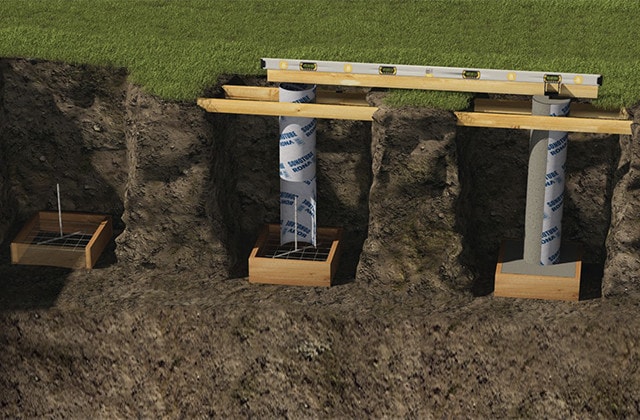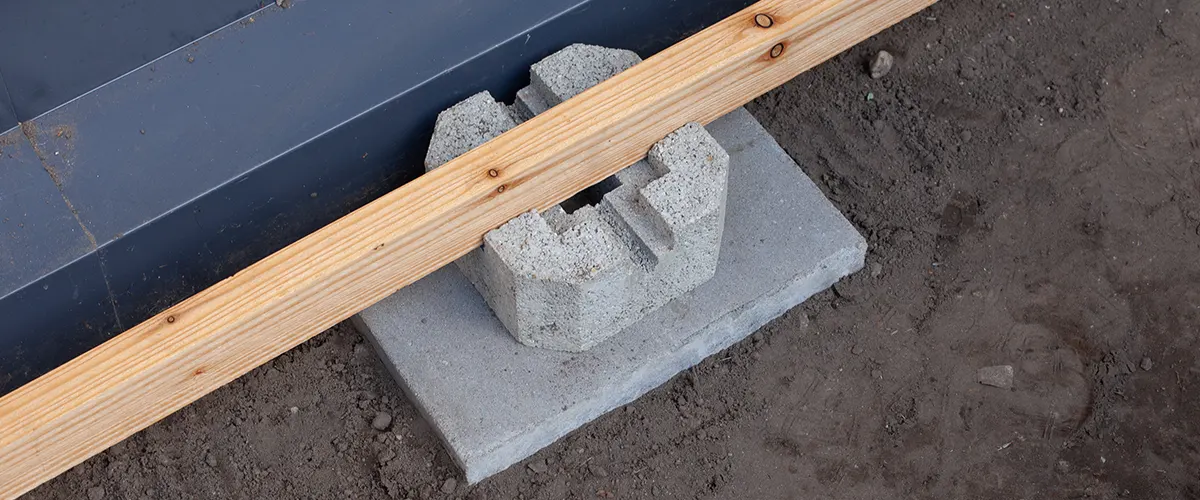Selecting the Right Deck Footings for Security and Sturdiness
When it involves constructing a deck, among the most critical choices you will certainly make is picking the right grounds for security and sturdiness. The long life and security of your deck depend greatly on the kind of grounds you select, as they give the essential support and security to stand up to the examination of time. With a myriad of choices available, it can be overwhelming to establish which grounds are best suited for your certain needs. In this discussion, we will explore the different types of deck grounds, think about the important elements to consider when making a decision, and dive right into the benefits and drawbacks of various options. By the end, you will certainly have a clearer understanding of the selections at hand and be far better equipped to make an educated choice for your deck project.
Kinds Of Deck Grounds
These footings are composed of a round hole filled up with concrete, which gives a strong foundation for the deck messages. Concrete pier footings are reasonably easy to set up and supply superb security, making them a preferred selection for many deck tasks.
One more sort of ground is the helical pile footing. Helical stacks are steel shafts with helical plates affixed to them. These footings are mounted by screwing them into the ground, which develops a safe and secure structure for the deck. Helical pile footings are excellent for locations with difficult soil conditions, as they can be set up in almost any kind of type of soil. They likewise enable for easy adjustment and leveling of the deck if needed.
Additionally, some contractors choose precast concrete grounds. These footings are made of long lasting concrete and be available in various sizes and shapes to fit various deck styles. Precast concrete grounds are convenient to mount and offer a steady base for the deck framework.
Ultimately, another alternative is the post-in-anchor footing system. This kind of ground involves driving a metal anchor into the ground and affixing it to the deck message. It supplies adaptability in regards to positioning the deck blog posts and is suitable for decks with light-weight frameworks.
When choosing the ideal kind of deck ground, it is important to take into consideration variables such as soil conditions, deck load, and regional building ordinance (Deck Footings). Consulting with a specialist service provider or structural designer can help make sure the appropriate footing is picked for a safe and steady deck
Factors to Think About When Picking Footings
When choosing the proper footings for a deck, it is critical to thoroughly take into consideration numerous factors such as dirt problems, deck load, and adherence to local building ordinance. These aspects play a considerable role in guaranteeing the stability and toughness of the deck framework.
Among the key elements to take into consideration is the dirt problems. The kind of dirt on which the deck will certainly be built determines the type of footings required. As an example, decks built on loosened or sandy dirts may need deeper footings to offer appropriate support and avoid settling. On the various other hand, decks developed on clay or extensive dirts might call for grounds that can fit the soil's tendency to expand and contract.
An additional important aspect is the deck tons. The weight of the deck, including the products used and any potential real-time tons such as furniture or events, have to be taken into account when choosing grounds. The grounds must be developed to birth the weight of the deck and distribute it evenly to prevent any type of structural concerns or failings.
Lastly, adherence to local building ordinance is vital. Building codes differ from area to region, and it is essential to abide with the particular needs set by the local authorities. Deck Footings. These codes make certain that the deck is developed securely and meets the needed standards for architectural integrity and load-bearing ability
Concrete Footings: Disadvantages and pros

When made use of as the foundation for a deck,Concrete grounds offer a number of advantages and drawbacks. On the favorable side, concrete grounds provide outstanding security and sturdiness. Concrete is a rigid and strong material that can support heavy loads and stand up to various weather. It likewise has a long life expectancy, making it a reputable choice for long-lasting use.
An additional benefit of concrete grounds is their flexibility. They can be poured into different sizes click to find out more and shapes to suit various deck styles and setups. Concrete footings can be customized to fit the details demands and demands of the deck framework.
However, there are likewise some drawbacks to utilizing concrete footings. This can boost the general cost of the deck task and may require specialist support.

Helical Piers Vs. Sonotubes: Which Is Much better?
In taking into consideration the structure alternatives for a deck, the comparison between helical piers and sonotubes is vital in establishing the superior choice. Helical piers, also referred to as screw piles, are steel shafts with helical plates affixed to them. They are twisted into the ground using hydraulic machinery, providing a resilient and stable foundation for the deck. On the various other hand, sonotubes are round kinds constructed from cardboard or fiber product that are full of concrete. They are positioned in an opening went into the ground and offer support for the deck.
The helical plates on the piers develop a strong hold with the dirt, pop over to this web-site protecting against any type of activity or moving of the deck. Sonotubes, on the other hand, depend solely on the concrete filling for security, which might not supply the very same degree of strength and resistance.
In regards to installation, helical piers are relatively less complicated and faster to install contrasted to sonotubes. The hydraulic equipment made use of to twist the piers into the ground ensures a reliable and fast procedure. Sonotubes, on the various other hand, require excavating holes and putting concrete, which can be labor-intensive and taxing.
In addition, helical piers are an even more versatile alternative. They can be used in various dirt problems and can be adjusted or reinforced if required. Sonotubes, on the other hand, might require additional support, such as rebar, in specific soil conditions or locations with high load needs.
Selecting the Right Footings for Your Deck's Dimensions
For ideal structural honesty, it is necessary to thoroughly choose the ideal footings that align with the measurements of your deck. The measurements of your deck, including its elevation, length, and width, play a significant role in establishing the kind and size of grounds called for.
When have a peek at these guys selecting grounds for your deck, it is very important to take into consideration the load-bearing ability of the soil. The weight of the deck, incorporated with the weight of any furniture or people on it, exerts a significant force on the grounds (Deck Footings). Therefore, it is critical to select footings that can effectively support this weight without moving or sinking over time.
Bigger decks with better measurements require larger grounds to provide sufficient security and assistance. The form of the footings, whether they are square or rounded, depends on the layout and layout of the deck.
Conclusion
Finally, selecting the ideal deck grounds is critical for ensuring stability and sturdiness. Aspects such as the kind of grounds, the deck's dimensions, and the benefits and drawbacks of various choices must be thought about. Concrete grounds offer toughness and longevity, but might be a lot more taxing and costly to install. Helical piers and sonotubes have their own advantages and negative aspects. Ultimately, selecting the ideal footings for your deck's specific needs is necessary for a effective and lasting structure.
These grounds consist of a cylindrical opening loaded with concrete, which gives a solid foundation for the deck articles. Concrete pier grounds are fairly simple to mount and supply outstanding security, making them a prominent choice for numerous deck projects.
Precast concrete footings are convenient to mount and provide a secure base for the deck structure.
It supplies versatility in terms of placing the deck articles and is ideal for decks with light-weight structures.
Concrete footings use several advantages and downsides when made use of as the foundation for a deck.